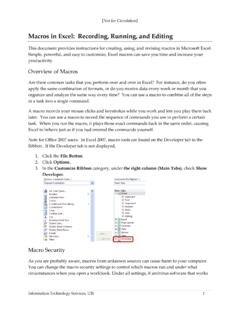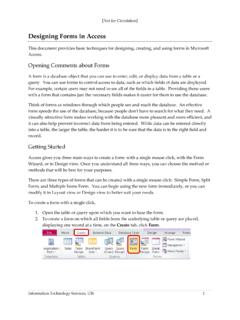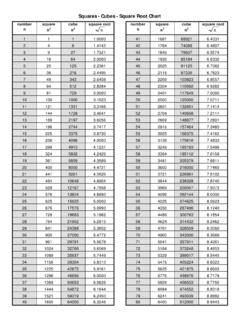Transcription of Square Roots and Other Radicals - UIS
1 Square Roots and Other Radicals Sponsored by The Center for Teaching and Learning at UIS Page | 1 Radicals - Definition Radicals , or Roots , are the opposite operation of applying exponents. A power can be undone with a radical and a radical can be undone with a power. For example, if you Square 2, you get 4, and if you take the Square root of 4, you get 2; if you Square 3, you get 9, and if you take the Square root of 9, you get 3: The symbol is called the radical symbol. Technically, just the check mark part of the symbol is the radical; the line across the top is called the vinculum. The expression is read as " root nine", "radical nine", or "the Square root of nine". Numbers can be raised to powers Other than just 2; you can cube things, raise them to the fourth power, raise them to the 100th power, and so forth.
2 In the same way, you can take the cube root of a number, the fourth root , the 100th root , and so forth. To indicate some root Other than a Square root , you use the same radical symbol, but you insert a number into the radical, tucking it into the check mark part. For example: The 3 inside the check mark part is the "index" of the radical. The "64" is "the argument of the radical", also called "the radicand". Since most Radicals you see are Square Roots , the index is not included on Square Roots . While " " would be technically correct, it is not used. Common Radicals : a Square (second) root is written as a cube (third) root is written as a fourth root is written as a fifth root is written as: Square Roots and Other Radicals Sponsored by The Center for Teaching and Learning at UIS Page | 2 You can take any counting number, Square it, and end up with a nice neat number.
3 But the process doesn't always work going backwards. For instance, consider , the Square root of three. There is no nice neat number that squares to 3, so cannot be simplified as a nice whole number. You can deal with in either of two ways: If you are doing a word problem and are trying to find, say, the rate of speed, then you would grab your calculator and find the decimal approximation of : Then you'd round the above value to an appropriate number of decimal places and use a real-world unit or label, like " ft/sec". On the Other hand, you may be solving a plain old math exercise, something with no "practical" application. Then they would almost certainly want the "exact" value, so you'd give your answer as being simply . Simplifying Square Roots To simplify a Square root , you take out anything that is a "perfect Square ".
4 That is, you take out front anything that has two copies of the same factor: Sometimes the argument of a radical is not a perfect Square , but it may contain a Square amongst its factors. To simplify, factor the argument and take out anything that is a Square . This means finding pairs inside the radical and moving it out front. To do this, use the fact that you can switch between the multiplication of Roots and the root of a multiplication. In Other words, Radicals can be manipulated similarly to powers: Square Roots and Other Radicals Sponsored by The Center for Teaching and Learning at UIS Page | 3 Examples Using Simplification of Square Roots Simplify There are various ways to approach this simplification. One would be by factoring and then taking two different Square Roots : The Square root of 144 is 12.
5 Another way to approach this simplification is if you already knew that 122 = 144, so the Square root of 144 must be 12. However, using the steps above, it is easier to see how to switch back and forth between the different formats (multiplication inside one radical, versus multiplication of two Radicals ) to help in the simplification process. Simplify Neither 24 nor 6 is a perfect Square , so simplify by putting them under one radical and multiplying them together. Simplify This answer is pronounced as "five, root three". It is proper form to put the radical at the end of the expression. Not only is "" non-standard, it is very hard to read, especially when hand-written. Write neatly, because "" is not the same as "". Simplify Since 72 factors as 2 36, and since 36 is a perfect Square , then: Since there was only one copy of the factor 2 in the factorization 2 6 6, the left-over 2 cannot come out of the radical and has to be left behind.
6 Square Roots and Other Radicals Sponsored by The Center for Teaching and Learning at UIS Page | 4 Simplify Variables in a radical's argument are simplified in the same way: whatever you've got a pair of can be taken "out front". Simplify Simplify The 12 is the product of 3 and 4, so I have a pair of 2's but a 3 left over. Also, I have two pairs of a's; three pairs of b's, with one b left over; and one pair of c's, with one c left over. So the root simplifies as: For radical expressions, any variables outside the radical should go in front of the radical, as shown above. Simplify Just use what you know about powers. The 20 factors as 4 5, with the 4 being a perfect Square . The r18 has nine pairs of r's; the s is unpaired; and the t21 has ten pairs of t's, with one t left over.
7 Then: Square Roots and Other Radicals Sponsored by The Center for Teaching and Learning at UIS Page | 5 Multiplying Square Roots In order to multiply Roots , they must first be simplified to make the process easier. Simplifying multiplied Radicals is pretty simple. Use the fact that the product of two Radicals is the same as the radical of the product, and vice versa. Write as the product of two Radicals : Simplify by writing with no more than one radical: Simplify by writing with no more than one radical: Simplify by writing with no more than one radical: Simplify by writing with no more than one radical: Square Roots and Other Radicals Sponsored by The Center for Teaching and Learning at UIS Page | 6 Adding and Subtracting Square Roots using Simplification Just as with regular numbers, Square Roots can be added together.
8 However, you might not be able to simplify the addition all the way down to one number. A good analogy to remember is: you can't add apples and oranges, so you also cannot combine unlike Radicals . To add radical terms together, they must have the same radical part. Simplify: Since the radical is the same in each term (the Square root of three), combine the terms. The problem states that we have two copies of the radical, added to another three copies. This gives five copies: That middle step, with the parentheses, shows the reasoning that justifies the final answer. You probably won't ever need to show this step, but it's what should be going through your mind. Simplify: The radical part is the same in each term, so perform the addition. To help keep track that the first term means one copy of the Square root of three, just insert the understood 1: Don't assume that expressions with unlike Radicals cannot be simplified.
9 It is possible that, after simplifying the Radicals , the expression can indeed be simplified. Simplify: To simplify a radical addition, first see if each radical term can be simplified. In this particular case, the Square Roots simplify completely down to whole numbers: Square Roots and Other Radicals Sponsored by The Center for Teaching and Learning at UIS Page | 7 Simplify: Here, we have three copies of the radical, plus another two copies, giving Wait a minute! Those Radicals can be simplified right down to whole numbers: Don't worry if you don't see a simplification right away. If you did not notice until the end that the radical simplified, your steps would have been different, but the final answer would have been the same: Simplify: Since we can only combine the like Radicals , we end up with two terms in the answer: Simplify: Remember: Radicals can only be added together if they have the same radical part.
10 Try to simplify the radical in the first term to create like terms: Square Roots and Other Radicals Sponsored by The Center for Teaching and Learning at UIS Page | 8 Simplify: Simplify as many of the Radicals as possible: Simplify: These two terms have unlike radical parts, and neither radical can be simplified. The expression cannot be simplified any further and the answer must be: (The expression is already fully simplified) Adding and Subtracting Square Roots using Expansion Expansion of Square Roots involves multiplying and then simplification. Expand: First, distribute the Square root of two across the parentheses: This simplification involved turning a product of Radicals into one radical containing the value of the product (being 2 3 = 6). Radicals may need to be manipulated in both directions in order to properly simplify.











